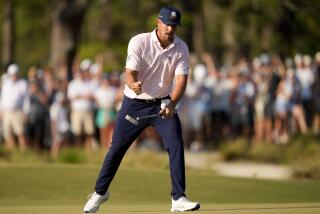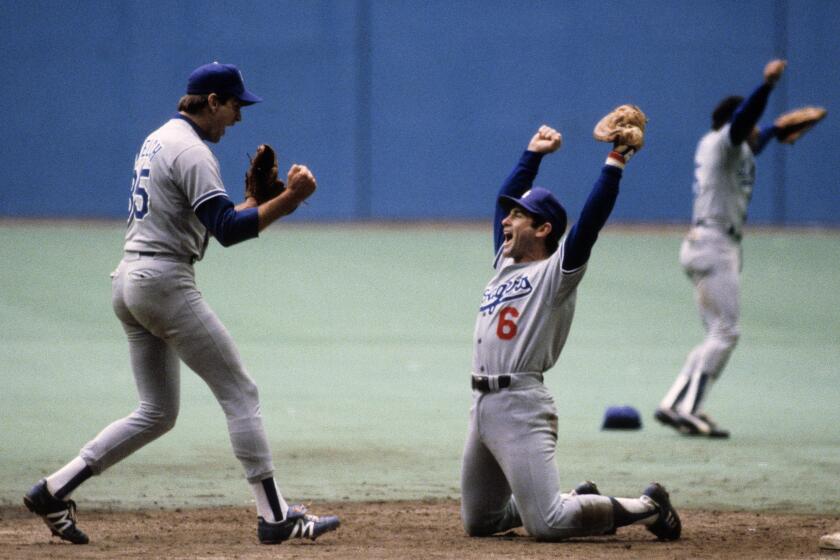Man of a Moment
When Payne Stewart arrived at Pinehurst six years ago for the U.S. Open, he hadn’t forgotten what had happened to him at the previous Open. He’d had a four-shot lead to start the last round at San Francisco’s Olympic Club but shot 74 and was passed by Lee Janzen, who closed with a 68.
Stewart was unhappy, from the tip of his tam o’ shanter to the bottoms of his trademark plus fours, since he had led after each of the first three rounds.
The first thing on his mind was the last thing he talked about at Pinehurst, and then only after his 15-foot uphill putt for par had disappeared into the bottom of the cup on the 72nd hole that Sunday in June 1999, when the 99th U.S. Open ended with a reversal of fortune for 42-year-old Payne Stewart, a major winner again.
“What happened last year at the U.S. Open, all my friends came up and said, ‘Boy, you sure tried.... It was a great effort.... You’re a great competitor.’ I didn’t want to hear that, and that motivated me,” Stewart said at the time.
Trying, competing weren’t good enough for him and if he had not won, he would have considered it falling short, being less a player than he expected of himself.
Stewart has been gone for nearly six years now, the victim of a freakish air disaster, but when the 105th edition of the U.S. Open is played this week on the same Pinehurst No. 2 layout where he bested Phil Mickelson by one shot, there will be plenty of memories.
Just behind the 18th green is a statue of Stewart, pumping his fist as if he were signaling a charge. There will be lofty tributes, kind words and tearful remembrances of a life and career cut short.
The U.S. Open was the 11th and final PGA Tour victory in Stewart’s career and his third major title, to go with his 1991 U.S. Open triumph and his first major championship, the 1989 PGA.
Four months later, on Oct. 25, 1999, Stewart, two of his agents, his golf course designer friend and two pilots died when their leased Learjet 35 en route from Orlando to Dallas suddenly lost pressure, veered wildly off course and crashed in swampland in South Dakota.
Stewart was inducted into the World Golf Hall of Fame in 2001. At that ceremony, Tiger Woods read an accolade. In part, it said, “Payne Stewart’s story is an inspiration to anyone who appreciates the spirit of a competitor.”
Woods was right. Even if Stewart didn’t like being called a great competitor when he lost, the tag fit.
*
Stewart was 4 when he started hitting golf balls while tagging along after his father, Bill, in Springfield, Mo. Bill Stewart had won the Missouri State Amateur and the Missouri Senior Amateur. He had also qualified for and played in the 1955 U.S. Open, at the Olympic Club.
Young Payne was quickly hooked on golf. He eventually earned a scholarship to Southern Methodist, where he was co-champion of the Southwest Conference in 1979. He turned pro that year but didn’t make it at the PGA Tour qualifying school.
So he did what anybody would do. He went to Asia, played the Asian Tour for two years and won twice. Actually, he won three times. He won two tournaments and when he was at a tournament in Kuala Lumpur, Malaysia, he met a woman named Tracey Ferguson, who soon became his wife. They were engaged in Singapore and married in 1981 in Southport on Australia’s Gold Coast.
He finally made it to the PGA Tour in 1982 and won his first tournament, the Quad Cities Open, with Bill Stewart in the gallery. He won again in 1983, the Walt Disney World, but his father was too ill with cancer to be there. Bill Stewart died two years later.
When Stewart won again at the 1987 Hertz Bay Hill Classic, he donated his check of $108,000 to the Florida Hospitals Golden Circle of Friends in memory of his father.
Despite those successes, the kind of memories Stewart was building were not what he had wished for. He lost four times in playoffs. And in 1985, he could have won both the U.S. Open at Oakland Hills and the British Open at Royal St. George’s, but lost the first by two shots and the other by one. He lost the 1986 U.S. Open at Shinnecock Hills in Southampton, N.Y., to Raymond Floyd, after leading with six holes left.
Everything changed for Stewart when he won his first major, the 1989 PGA Championship at Kemper Lakes in suburban Chicago, where he was five shots behind with nine holes to play and won by one shot. He won his second major soon after with a playoff victory at the 1991 U.S. Open at Hazeltine in Chaska, Minn., coming from two shots behind with three holes to play to catch Scott Simpson.
He battled swing problems and injuries the next few years, but rebounded when he found faith. He and Tracey grew closer and Payne began wearing a “WWJD” bracelet, for “What Would Jesus Do,” given to him by his son, Aaron. The Stewarts also had a daughter, Chelsea.
In 1995, he scored a victory at the Shell Houston Open, and then really seemed to find his game when he won the 1999 AT&T; Pebble Beach National Pro-Am.
The U.S. Open at Pinehurst was four months away.
*
When it came to major championships, Pinehurst was getting lonely. When the 1999 U.S. Open rolled into town, it had been 63 years since Pinehurst had been the scene of a major, the 1936 PGA Championship won by Denny Shute.
The gem of course designer Donald Ross’ architectural career, Pinehurst represented -- and still does -- a stern test, placing a premium on accurate drives down narrow fairways, unerring iron play and nerveless putting on lightning-fast greens.
None of that bothered Stewart, though, nor did the cool, cloudy conditions. He opened with a two-under 68, then took over with a 69 in the second round. After his two-over 72 in the third round, Stewart found himself looking over his shoulder at the rest of the field.
As he began the last round, Stewart was a shot ahead of Mickelson, two ahead of Woods and Tim Herron. But before he even began the fourth round, Stewart listened to advice from Tracey, who, after watching him take 31 putts on Saturday, told him he needed to keep his head still when putting.
Maybe it was all he needed to hear, because no one putted better than Payne Stewart on that last day of what would be his last victory.
He got off to a good start with birdies at the first and third, sandwiched around a bogey at the par-four second. One under with a 34 on the front, Stewart couldn’t shake Mickelson, who shot his own 34.
Mickelson could have been forgiven if he had let his concentration lag. He played while wearing a beeper to warn him that his wife, Amy, was going into labor. They had agreed that if the beeper sounded, he would walk off the course. It never did, and Mickelson, playing focused golf, stayed through the last putt on the last hole.
After the turn, Stewart found trouble quickly. At the 607-yard par-five 10th, he drove into a fairway bunker and missed a 10-footer that would have saved his par. He made par at the 11th, then hit another bad drive on the par-four 12th that led to another bogey. Mickelson passed him on the leaderboard.
Stewart regained a share of the lead when he made a 15-foot putt to birdie the 13th, but when he made a bogey at the 15th, Mickelson was again in the lead by one shot.
With a one-shot lead and three holes to go, Mickelson stood on the tee at the par-four 16th, trimmed down from a par five for the Open, a 489-yard hole that ranked as the longest par four in major championship golf.
It seemed an advantage for the longer-hitting Mickelson. Instead, it was where the Open turned its face toward the guy in the blue tam, blue sweater, red and blue shirt, black slacks, white socks and shoes and the puckish expression.
Even at that, it took some doing. Stewart left his second shot short, hit a poor chip onto the green and had a 25-foot putt to save par. Meanwhile, Mickelson’s third shot was eight feet from the hole and his chance for a two-shot lead with two holes to go looked good.
That’s not how it played out. Stewart’s long putt broke left, broke right, hit the back of the cup, popped up in the air and fell in. He had saved par. Mickelson two-putted for his only bogey of the day. They were tied.
The 17th is a par-three and Stewart was first with a six-iron. He stopped the ball four feet from the hole. Mickelson’s seven-iron was just outside Stewart’s ball, about eight feet from the pin. But he missed his birdie putt and settled for par, and Stewart knocked his putt toward the left edge and watched it fall in for birdie.
So, he had a one-shot lead with one hole to play, the par-four 18th, mostly uphill and 442 yards of it.
Stewart promptly drove into the rough, in grass so thick he had no chance at going for the green, so he had to lay up to about 70 yards from the hole. Mickelson’s second shot reached the green, about 25 feet from the hole.
Next, Stewart’s wedge landed 15 feet below the hole.
Mickelson’s turn. If he makes it, all the pressure is on Stewart. The ball broke right to left, rolled toward the cup but stayed out.
Stewart’s turn, and later, he recalled his thoughts: “You’ve always wanted a putt to win the U.S. Open. Well, you’ve got it right here.”
Stewart remembered Tracey’s warning to keep his head still. He stroked the putt and the ball started rolling up the hill, breaking slightly to the right before it disappeared completely from sight and directly into history.
“When I looked up, it was about two feet away from the hole and breaking right into the center of the cup,” he said. “I couldn’t believe my eyes. I couldn’t believe I had achieved my dream.”
Stewart celebrated, consoled Mickelson by telling him he’d soon make a great father, then found Tracey to continue the celebration.
*
Sometime this week, probably every day, Payne Stewart will be mentioned, discussed, quoted, missed. He will be remembered for his skill under pressure on the last day at Pinehurst in 1999.
Of the 67 players who’d made the cut, only two shot lower than Stewart on Sunday. Vijay Singh, who tied for third with Woods, and Dudley Hart, who tied for 17th, had 69s.
Stewart’s winning putt, his 15-footer at the 18th, remains the longest made by a player in the final group on the 72nd hole who won the U.S. Open by one shot.
That September, Stewart helped anchor the U.S. Ryder Cup team to a victory over Europe. It was his fifth Ryder Cup berth, but his first in six years.
A month later he was dead.
More than two weeks after the crash, Tracey Stewart received personal effects that had been recovered from the crash scene. One of the items was Stewart’s wedding band. They will probably remember that at Pinehurst this week, too.
*
(BEGIN TEXT OF INFOBOX)An American classic
A month after his United States team rallied to win the Ryder Cup, and four months after his victory in the U.S. Open at Pinehurst, N.C., Payne Stewart died at 42 while flying in a Learjet from Florida to Texas. A look at his three major victories:
1989 PGA Championship
* Stewart rallies with four birdies in the last five holes and shoots a five-under-par 31 on the back nine in the final round to defeat Mike Reid by one shot at Kemper Lakes Golf Club in Hawthorn Woods, Ill.
1991 U.S. Open
* Despite shooting 75 in an 18-hole playoff, Stewart wins the title because Scott Simpson shoots a 77 after they finish tied for the lead in regulation at Hazeltine National Golf Club in Chaska, Minn.
1999 U.S. Open
* Trailing Phil Mickelson by one shot with three holes to go, tied with two to play and ahead by one at No. 18, Stewart makes a 15-foot putt to save par, avoid a playoff and earn the victory.
*
Los Angeles Times
*
105th U.S. Open
Pinehurst No. 2 is one of the most famous courses designed by Donald Ross, who completed the course in 1907:
* Course highlights: The predominant features are the domed greens. Pinehurst No. 2 has 52 fairway bunkers and 57 greenside bunkers. It has only one water hazard, on No. 16, although it does not come into play. It will play 92 yards longer than the 1999 U.S. Open here, and will match Bethpage Black as the longest course in U.S. Open history.
* Course highlights: Retief Goosen
* Length: 7,214 yards.
* Par: 35-35--70.
* Format: 72 holes of stroke play.
* Cut: Top 60 and ties, and anyone within 10 strokes of the lead after 36 holes.
* Playoff, if necessary: 18 holes of stroke play on June 20.
* Field: 156 players (nine amateurs).
* Purse: TBA ($6.25 million in 2004).
* Winner’s share: TBA ($1,125,000 in 2004).
* Last year: Retief Goosen one-putted the final six holes and closed with a one-over 71 at Shinnecock Hills to finish at 276 for a two-shot victory over Phil Mickelson. Goosen’s 12-foot birdie putt on the par-five 16th gave him a share of the lead.
* On TV: (times PDT): Thursday and Friday, 7 a.m. to noon, ESPN; noon to 2 p.m., Ch. 4; 2 p.m. to 4 p.m., ESPN. Saturday and Sunday, 9:30 a.m. to 4 p.m., Ch. 4.
*
-- Associated Press
More to Read
Go beyond the scoreboard
Get the latest on L.A.'s teams in the daily Sports Report newsletter.
You may occasionally receive promotional content from the Los Angeles Times.










